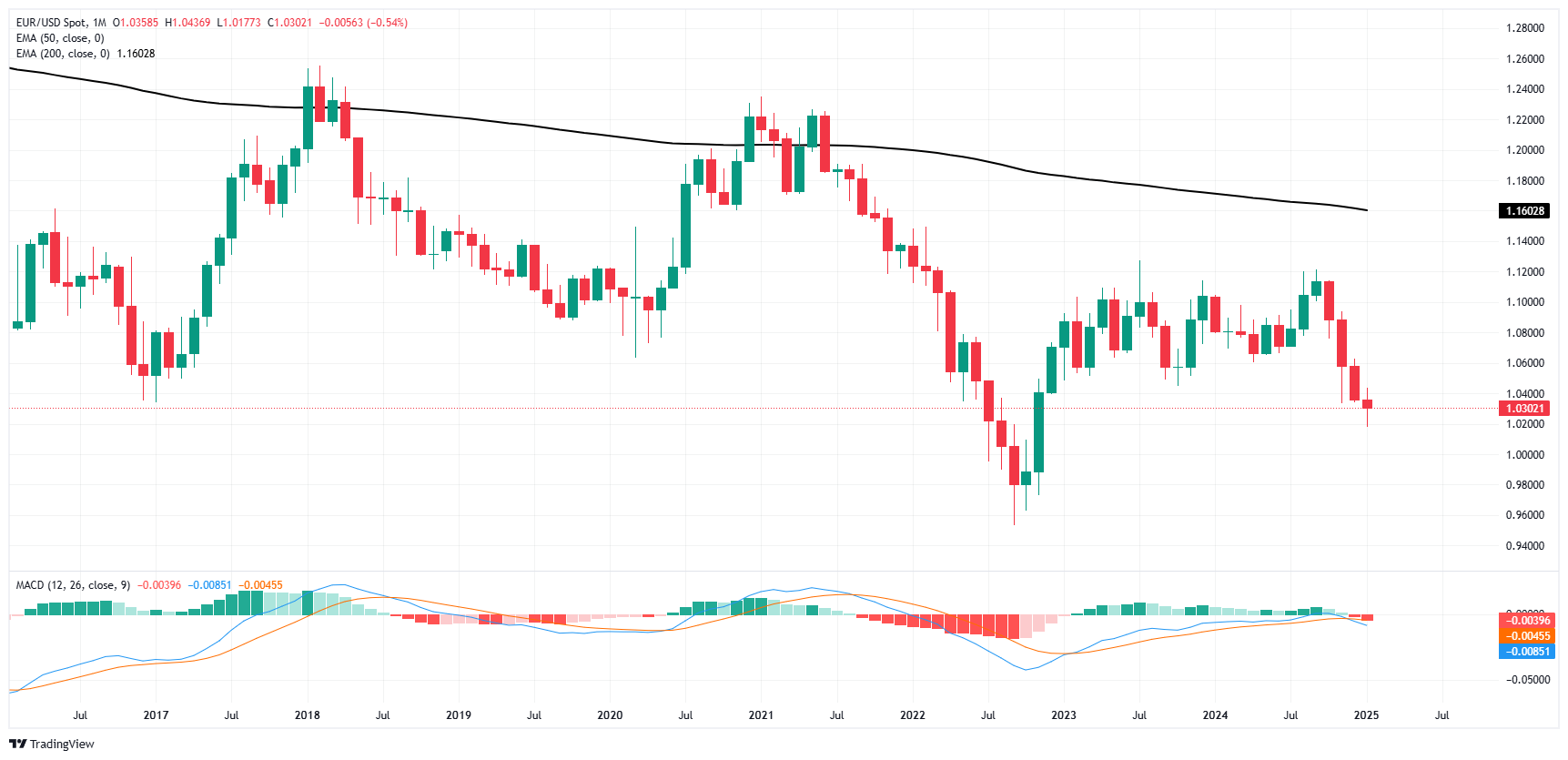- EUR/USD went in a circle on Thursday, stuck in the 1.0300 area.
- Final German inflation figures hit target, EU figures are expected to do the same.
- US data is limited on Friday as Fiber operators slow down.
EUR/USD remained in the middle of Thursday’s market action with bids stuck in the 1.0300 price zone. There is limited supply on the economic calendar on Friday, and traders will be on the lookout for any rumors from central bank policymakers.
Germany’s Harmonized Index of Consumer Prices (HICP) inflation figures came in exactly as markets expected on Thursday, not exactly a big reach as they were non-preliminary figures and rarely change unless things go disastrously wrong. Retail sales figures moderated in December, retreating to 0.4% month-on-month in the headline figure. Markets were expecting a decline to 0.6% from the previous month’s revised 0.8%. Core retail sales excluding automotive expenses rose to 0.4% month-over-month from 0.2%, meeting analysts’ median forecasts. The mixed numbers failed to cause significant changes in investor sentiment in either direction.
For Friday, there is little of interest in the data calendar, with more non-preliminary HICP inflation figures for the broader pan-European economic zone expected to confirm a slight rise to 2.8% year-on-year from 2.7%. On the US side of the Atlantic, the December Housing Starts, Building Permits and Industrial Production numbers are expected to remain relatively close to previous numbers, and are unlikely to drive much volatility in the market on their own.
EUR/USD Price Forecast
Fiber has extended into a two-day flat reversal, with bids stuck in the 1.0300 technical zone. Price action has moderated after testing the 1.0200 zone last week, setting a new 26-month low in the process. Bullish recovery attempts have so far failed to materialize in any significant way, although EUR/USD is slowly recovering from what is otherwise shaping up to be the fourth consecutive calendar month of declines in the forex market’s most traded pair.
EUR/USD Daily Chart
Euro FAQs
The Euro is the currency of the 19 countries of the European Union that belong to the eurozone. It is the second most traded currency in the world, behind the US dollar. In 2022, it accounted for 31% of all foreign exchange transactions, with an average daily turnover of more than $2.2 trillion per day. EUR/USD is the most traded currency pair in the world, accounting for an estimated 30% of all transactions, followed by EUR/JPY (4%), EUR/GBP (3%) and EUR/AUD (2 %).
The European Central Bank (ECB), headquartered in Frankfurt, Germany, is the reserve bank of the eurozone. The ECB sets interest rates and manages monetary policy. The ECB’s primary mandate is to maintain price stability, which means controlling inflation or stimulating growth. Its main tool is the increase or decrease in interest rates. Relatively high interest rates (or the expectation of higher rates) tend to benefit the euro and vice versa. The Governing Council of the ECB makes decisions on monetary policy at meetings held eight times a year. Decisions are made by the directors of the Eurozone’s national banks and six permanent members, including ECB President Christine Lagarde.
Eurozone inflation data, measured by the Harmonized Index of Consumer Prices (HICP), are an important econometric indicator for the euro. If inflation rises more than expected, especially if it exceeds the ECB’s 2% target, it forces the ECB to raise interest rates to bring it back under control. Relatively high interest rates compared to their counterparts tend to benefit the euro, making the region more attractive as a place for global investors to park their money.
The published data measures the health of the economy and may have an impact on the euro. Indicators such as GDP, manufacturing and services PMIs, employment and consumer confidence surveys can influence the direction of the single currency. A strong economy is good for the Euro. Not only does it attract more foreign investment, but it may encourage the ECB to raise interest rates, which will directly strengthen the euro. Otherwise, if economic data is weak, the Euro is likely to fall. Economic data for the four largest eurozone economies (Germany, France, Italy and Spain) are especially significant, as they represent 75% of the eurozone economy.
Another important data that is published about the Euro is the trade balance. This indicator measures the difference between what a country earns from its exports and what it spends on imports during a given period. If a country produces highly in-demand export products, its currency will gain value simply from the additional demand created by foreign buyers seeking to purchase those goods. Therefore, a positive net trade balance strengthens a currency and vice versa in the case of a negative balance.
Source: Fx Street
I am Joshua Winder, a senior-level journalist and editor at World Stock Market. I specialize in covering news related to the stock market and economic trends. With more than 8 years of experience in this field, I have become an expert in financial reporting.







